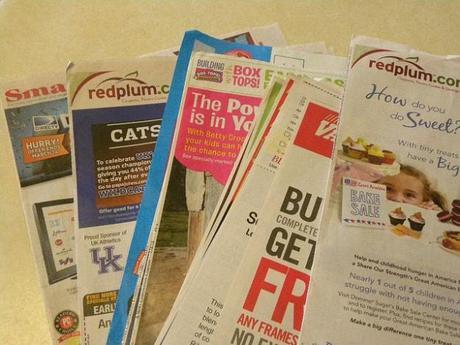
Photo courtesy Hobbies on a Budget on Flickr
Last week I wrote about the best resources for saving money with grocery coupons. These tools are available to everyone, but not everyone manages to save hundreds of dollars on their grocery bill each month. What sets the super-couponers apart from everyone else?
In fact, it is possible that grocery coupons can cause you to spend more money. Manufacturers and brands do not print coupons out of the goodness of their hearts, they do it because many people will end up spending more on their products by using the coupons.
Here are the essential strategies you should follow to make sure you save the most money when buying food for your family.
Buy What You Use
It does not matter if you get 50 cans of cat food for only a nickel a can if you do not have a cat. While $1 for a box of brand name cereal is a great price these days, if you do not usually eat it then you are not saving money; rather you have fallen into the coupon trap.
Major brands print coupons to encourage people to purchase their products, and to motivate people to buy them that might not usually do so. Discarding coupons for products you do not use, or donating them to a food pantry, is not a waste of money. It is a matter of choosing to buy the things you were going to buy anyway.
Use Coupon Match Ups For Incredible Deals
Coupon match ups occur when you combine multiple coupons or discounts for a spectacular deal. For example, using a store coupon, a manufacturer’s coupon, and a rebate on an item that was on sale to pay pennies for a grocery item.
You could spend hours matching up your coupons to the local sales flyers. It is much more efficient to follow some bloggers that regularly make these matchups for you – I linked to several in last week’s post on grocery coupon resources.
You can also find matchups buy using Google to search for discussions or posts about your local grocery store chain. Use queries like “Kroger coupon matchups” or “Meijer coupon deal match.” You will likely find a site that you can just check on each week to plan your money saving grocery trip.
Know Your Store’s Coupon Policy
You should be well-versed in your local grocery stores’ coupon policies. Do they double coupons? If so, which ones and how often? Do they take competitor’s store coupons? Where can you get their store coupons?
When you use coupons, you may encounter the under-informed or poorly trained cashier or manager who does not know their own store coupon policy. They may refuse digital coupons, or tell you that you cannot use a store coupon and a manufacturer coupon.
Having a printout of the store’s policy can help you smooth over those unpleasant experiences. I once knew an extreme couponer who kept the corporate number for the local grocery chains on her mobile phone’s address book. On more than one occasion a quick call cleared up the local manager’s misunderstandings about coupons.
Know the Regular Price For Your Most Used Products
In the old days, pre-Internet, people like Amy Dacyczyn of the Tightwad Gazette recommended keeping a price book. This was simply a notebook in which you listed the regular price for groceries you bought regularly, and maybe a few recent sale prices. Armed with this knowledge, you knew when a deal really was a deal, and could make the most of it.
This is still a good idea. The price for a product at once local store, with a coupon, may be still more than the regular low price at another store. Very often, the price for a name-brand product, with coupon, is more than the store brand’s regular price.
Knowing the lowest regular price can make sure that you use your coupons to actually save money, instead of spending more for an advertised product.
Stock Your Shelves
Great deals come all the time, but unless you are going to seize the deal, your savings will be small.
I did a deal many years ago, when a major soup company introduced a new deluxe line of soups. The register would print a coupon for the soup when you bought a certain quantity, and the local store was having a great discount – two promotions to encourage purchasing more soup.
Once you bought 3 or 4 soups without a discount, each order after that would end up costing around 11 cents a can for a $2 can of soup. However, if you just did the deal once, you did not save much off the regular price. The deal really kicked in when you bought dozens of the products.
This meant many trips through the checkout line, or bringing a lot of cans to a self-checkout counter during very slow hours when you were not holding up other shoppers.
At home, we had a winter’s supply of soup for a two-family household. Cans filled shelves, were stacked in corners, and stored under beds. We were still eating that soup a year later.
It is important to note that stockpiling during deals will completely change your shopping rhythm. Extreme couponers shop the products on sale, and make a meal plan based on what they have “in stock” at home. An entire week’s budget might be spent on a single type of food (like soup) in order to eliminate it from the shopping list for months to come. Next week, other hot deal items will make up most of the food budget.
Get Lots of Coupons
To take advantage of deals over and over, you will need a lot of coupons to exploit the best matchups.
While you can get digital coupons online, they are usually limited to only 2 coupons per computer. Software limitations prevent you from printing more than that.
Another source for coupons is the Catalina printer – those coupons that print at checkout, often with red stripes on the edges. Some of those offers are national and you coupon matchups will tell you what deals are offered and what coupons will print and when.
But for all the technology, the best way to get coupons is still the Sunday paper. It is generally not worth paying the cost of a Sunday edition just for the coupons, though. Just about every super couponer I have known had worked out a deal with someone involved in newspaper distribution: their carrier, the local distributor, the printer, or even retailers who had extra Sunday papers later in the week.
While you can trade or order coupons and inserts from others, this is frowned upon by manufacturers and brands that print them.
Be Organized
Obviously with all those coupons, sales flyers, and matchup information you will have to have a system for organizing your coupons and your shopping trips, or you will spend hours looking for things every week.
Again, there were several ideas posted in last week’s grocery coupon resources post. You will probably find a hybrid solution that works best for you, hopefully after as few missteps as possible. Mistakes happen, and if you are just starting out with coupons the amount of information and paper you will be processing can be overwhelming at first.
Don’t Be a Brand Snob
Using coupons means being flexible to get the best deal. That means little or no brand loyalty when it comes to brands of food or store chains. You have to be prepared to purchase the best priced product, whether it is at the grocery store you always shopped at before or the brand of cheese that you always used to buy.
In some cases, you may only have one grocery store close enough to shop at regularly. However, if you live in a major metropolitan area, may have 3 or 4 major chains competing with one another. Be ready to make partial shopping trips at different stores in order to snag the best deals at each!
Please share your best grocery coupon shopping strategies below!

